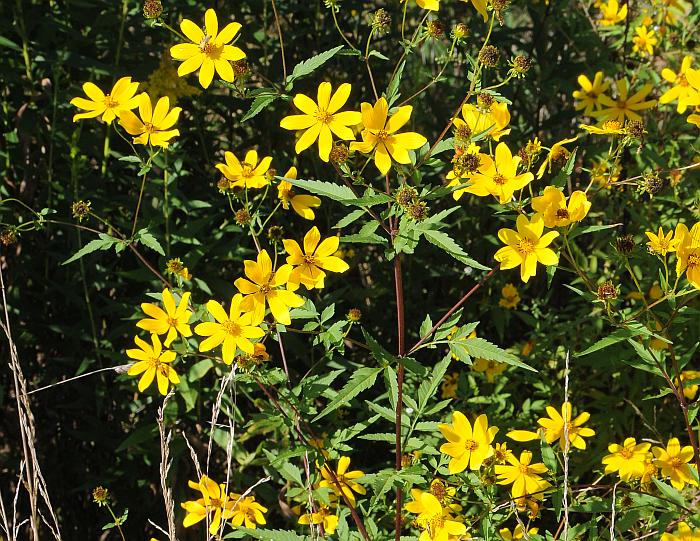Bidens aristosa (Michx.) Britton
Tickseed Sunflower

Native
CC = 1
CW = -3
MOC = 90
© SRTurner
Bidens aristosa (Michx.) BrittonTickseed Sunflower | |
 |
Native CC = 1 CW = -3 MOC = 90 |
© SRTurner |
|
Family - Asteraceae/Heliantheae Habit - Annual or biennial forb, from fibrous roots or sometimes taproots. Stems - Ascending to erect, to 1 m, branching, often purplish or mottled, 4-angled, (the angles rounded), glabrous to sparsely antrorse-pubescent.
Leaves - Opposite, petiolate, deeply lobed or compound. Petioles 3 cm, with an adaxial groove (the groove sparsely pubescent). Blades to 15 cm, lanceolate or ovate or triangular in outline, all but uppermost deeply 1-2x pinnately divided into 3-7 segments or leaflets. Ultimate divisions lanceolate to linear-lanceolate, sharply toothed, the terminal division being the largest, to 10 cm long, 1.5 cm broad, deep dull green and very sparsely antrorse-pubescent above, light green and antrorse-pubescent below. Leaves reduced upward.
Inflorescence - Solitary terminal heads or loose clusters of heads. Heads - Radiate, not nodding. Involucre flat, the outer series of 8-25 bracts 4-12 mm long, spreading or reflexed, mostly not leaflike, linear, often twisted, the margins entire but usually with short, spreading hairs, the outer surface glabrous or with short, spreading hairs; the inner series of 6-8 bracts 4-12 mm long, narrowly lanceolate to narrowly ovate, glabrous. Chaffy bracts narrowly lanceolate, usually with broad, yellowish margins and tip, occasionally purplish-tinged at the tip, glabrous.
Flowers - Ray florets 5-8 per head, sterile, with showy ligule to 3 cm long, yellow, glabrous, the apex blunt to very shallowly 2-3 notched. Disk florets 20-80 per head, perfect, the corollas 2.0-3.5 mm long, 5-lobed, yellow. Corolla tube constricted in lower 1/2, funnelform in upper 1/2, glabrous, to 4 mm long. Corolla lobes acute, spreading to erect, 0.7 mm long. Stamens 5, adnate at apex of corolla tube constriction. Filaments to 1.2 mm long, glabrous, pale yellow. Anthers connate around style, purplish-brown, exserted, to 2.1 mm long. Style bifurcate, yellow in apical portion (stigma). Pappus reduced to a minute crown with 2 teeth, or more commonly of 2 awns variously 0.5-4.0 mm long, these with upward- or downward-pointed barbs, erect to somewhat spreading at fruiting.
Flowering - August to October. Fruits - Achenes 4-8 mm long, wedge-shaped to obovate (mostly 1.5-2.5 times as long as wide), flattened and somewhat 3-angled in cross-section, the angles roughened with short, stiff, ascending, pustular-based hairs, the faces sometimes with few to several faint longitudinal lines, dark brown to black, sparsely to moderately pubescent with short, fine, mostly appressed hairs. Habitat - Prairies, bottomland forests, pond margins, sloughs, ditches, fields, roadsides, railroads.
Origin - Native to the U.S. Lookalikes - Other members of the genus, especially B. trichosperma and B. polylepis. Other info. - This species is common throughout Missouri. Its U.S. range includes most of the Midwest and extends into Canada. The plant is often observed along roadsides, and under favorable conditions it can form large, very showy populations of bright yellow. It is very striking and popular with flying insects. The combination of bright yellow heads and compound leaves with toothed leaflets is distinctive and makes for easy identification, at least to the genus level. Photographs taken off Hwy C, Carter County, MO., 8-31-03 (DETenaglia); also at Prairie Slough Conservation Area, 9-20-2010, Johnson's Shut-Ins, 9-8-2014, and Catawissa Conservation Area, Franklin County, MO, 9-14-2017 (SRTurner). |